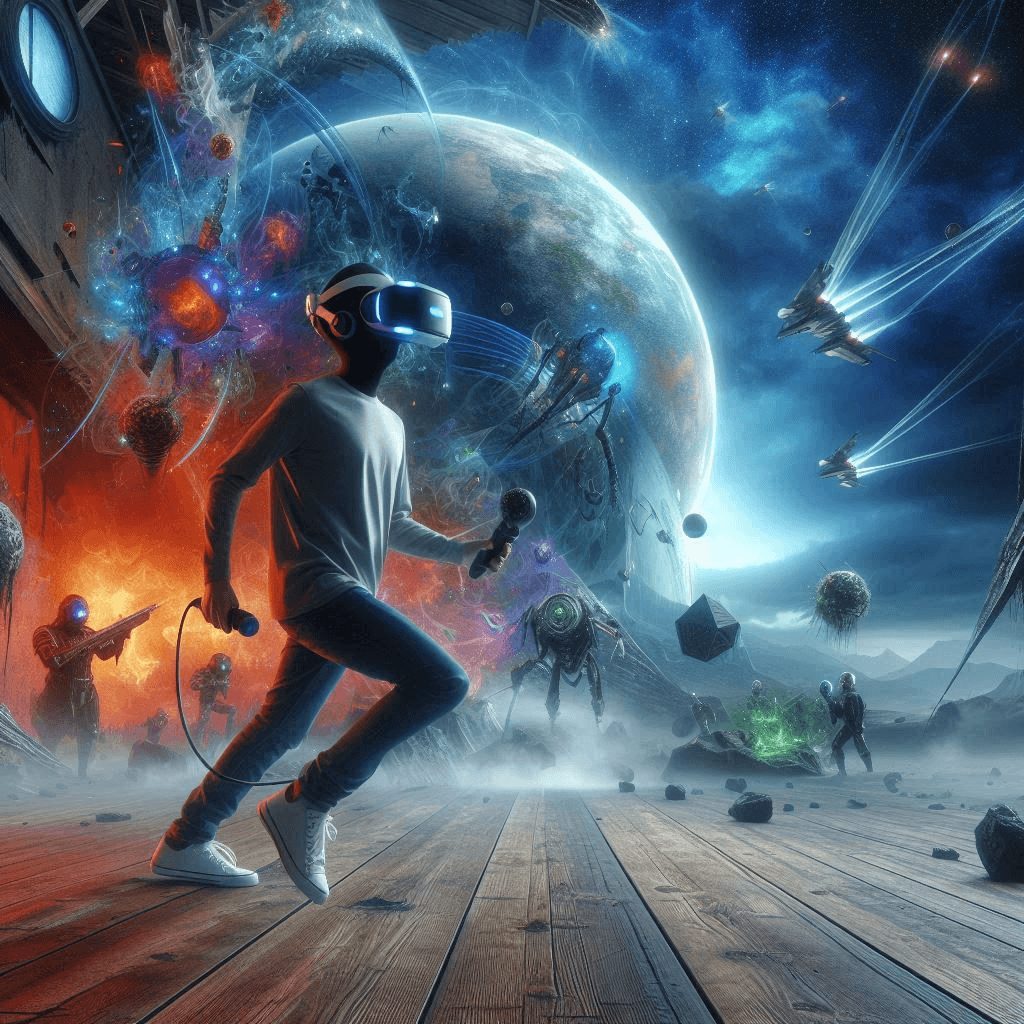In the ever-evolving world of gaming, the emergence of VR Gaming technology has ushered in a new era of extraordinary and immersive experiences. Gone are the days of flat screens and traditional controllers – VR has revolutionized the way we interact with and become engrossed in digital worlds. This article delves into the captivating realm of immersive VR games, exploring their groundbreaking features, the impact they have had on the gaming industry, and the future possibilities that lie ahead.
The Rise of Immersive VR Gaming
The concept of virtual reality has been around for decades, but it is only in the past few years that the technology has advanced to a point where it can deliver truly immersive and captivating gaming experiences. The introduction of high-resolution head-mounted displays, advanced motion tracking systems, and powerful game engines have all contributed to the meteoric rise of VR gaming.
One of the key drivers of this growth has been the increasing accessibility and affordability of VR hardware. Headsets like the Oculus Rift, HTC Vive, and PlayStation VR have brought the technology into the mainstream, making it more attainable for a wider audience. As the prices of these devices have dropped and the quality has improved, more and more gamers have been able to experience the magic of VR firsthand.
Immersion and Presence: The Cornerstones of VR Gaming
At the heart of the VR gaming experience is the sense of immersion and presence that it creates. Unlike traditional gaming, where the player is separated from the on-screen action, VR immerses the user in the virtual world, making them feel as though they are truly present within the game.
This sense of presence is achieved through a combination of factors, including the 360-degree field of view, stereoscopic 3D, and the ability to look around and interact with the environment using intuitive motion controls. When a player puts on a VR headset, they are instantly transported to a new reality, where their senses are fully engaged, and they can freely explore and interact with the digital landscape.
The level of immersion in VR gaming also extends to the player’s physical movement and interaction with the game world. Many VR titles incorporate room-scale tracking, which allows users to physically move around and explore the virtual environment, further blurring the line between the real and the digital. This level of embodiment and physical engagement is a key aspect of what makes VR gaming so captivating and transformative.
Groundbreaking Game Designs and Experiences
The unique capabilities of VR technology have enabled game developers to create groundbreaking and innovative gaming experiences that simply weren’t possible with traditional gaming platforms. These immersive VR games offer a level of immersion and interactivity that truly sets them apart from their flat-screen counterparts.
One of the most notable examples of this is the first-person shooter (FPS) genre, which has been revolutionized by VR. Games like “Pavlov VR” and “Onward” provide a level of tactical realism and physical engagement that simply can’t be replicated on a standard monitor. Players can physically duck, weave, and take cover, while using their hands to reload weapons, toss grenades, and communicate with teammates in a truly visceral and immersive manner.
Beyond the FPS genre, VR has also opened up new possibilities for exploration and adventure. Titles like “The Climb” and “Arizona Sunshine” allow players to scale towering cliffs, navigate through post-apocalyptic landscapes, and engage in intense zombie-slaying, all with a level of presence and realism that is unmatched by traditional gaming.
VR has also had a significant impact on the horror genre, with games like “The Exorcist: Legion VR” and “Resident Evil 7” delivering a level of terror and suspense that is truly unsettling. The sense of being completely immersed in these virtual worlds, with the ability to look around and interact with the environment, creates a level of psychological and emotional engagement that is unparalleled.


The Rise of Social and Multiplayer VR Experiences
One of the most exciting developments in the world of VR gaming has been the emergence of powerful social and multiplayer experiences. These games and applications allow users to connect with others in virtual environments, fostering a sense of community and shared experience that is uniquely VR.
Games like “Rec Room” and “VRChat” have become popular hubs for VR users to meet, socialize, and engage in a variety of multiplayer activities, from competitive games to creative collaborative experiences. These platforms offer a level of social interaction and shared presence that is simply not possible in traditional gaming.
The integration of voice communication, hand gestures, and even full-body avatars has enabled VR users to communicate and interact with one another in a more natural and intuitive way. This has led to the development of virtual social spaces, where users can gather, explore, and engage in a wide range of activities, from casual conversations to organized events and meetups.
The emergence of these social VR experiences has also opened up new possibilities for educational, artistic, and professional applications. Virtual classrooms, collaborative workspaces, and even virtual concerts and art exhibits have all become viable and engaging experiences within the VR realm.
The Future of Immersive VR Gaming
As the VR gaming industry continues to evolve, the future holds even more extraordinary and captivating experiences. With advancements in hardware, software, and game design, the potential for VR to transform the way we play, learn, and interact is truly limitless.
One of the most exciting developments on the horizon is the increasing integration of artificial intelligence (AI) and machine learning into VR gaming. By leveraging these technologies, developers can create more intelligent and responsive virtual environments, with non-player characters (NPCs) that can engage in more natural and contextual interactions with the player.
Additionally, the continued refinement of haptic technology, which can provide tactile feedback and sensations, will further enhance the sense of embodiment and physical presence in VR games. Imagine being able to feel the texture of a virtual surface, the weight of a weapon, or the resistance of an object – this level of sensory feedback will undoubtedly take the game insights experience to new heights.
As the VR industry continues to evolve, we can also expect to see more seamless integration between the virtual and physical worlds. Advancements in mixed reality (MR) technologies, which blend digital and physical elements, will allow for even more immersive and interactive experiences. Imagine being able to interact with virtual objects in your physical environment or having virtual characters and environments seamlessly integrated into the real world.
Furthermore, the ongoing development of 5G and cloud gaming technologies will open up new possibilities for VR gaming, enabling more powerful and responsive experiences, as well as the ability to share and collaborate in virtual spaces with greater ease and accessibility.
Conclusion
The world of immersive VR gaming has truly arrived, offering players a level of engagement, interactivity, and presence that was once the stuff of science fiction. Through groundbreaking game designs, captivating social experiences, and the continued advancement of VR technology, the future of gaming is poised to become even more extraordinary and transformative.
As we step into this new dimension of play, the possibilities are endless. From heart-pounding FPS experiences to awe-inspiring exploration and adventure, VR gaming has the power to transport us to worlds we never thought possible. With the industry continuing to evolve and innovate, the future of immersive gaming is sure to be a thrilling and unforgettable journey.
FAQs
-
What makes VR gaming so immersive and engaging compared to traditional gaming?
VR gaming provides a greater sense of presence and embodiment within the virtual world through features like 360-degree field of view, stereoscopic 3D, and intuitive motion controls. This level of immersion and physical interaction creates a more compelling and transformative gaming experience.
-
How has VR technology impacted the development of new game genres and experiences?
VR has enabled the creation of groundbreaking game genres and experiences that simply weren’t possible with traditional gaming platforms. This includes the transformation of first-person shooter games, the rise of exploration and adventure titles, and the development of highly engaging horror experiences.
-
What are some of the key advancements in VR technology that are shaping the future of immersive gaming?
Ongoing advancements in areas like hardware, software, artificial intelligence, and haptic technology are all contributing to the evolution of VR gaming. Expect to see more intelligent virtual environments, enhanced sensory feedback, and seamless integration between the virtual and physical worlds.
-
How has VR impacted the social and multiplayer aspects of gaming?
VR has enabled the development of robust social and multiplayer experiences, where users can connect, interact, and engage in a variety of activities within virtual environments. This has led to the creation of virtual social spaces and the exploration of new applications for VR technology, such as education, collaboration, and entertainment.
-
What are the future implications of VR gaming, and how might it continue to transform the way we play, learn, and interact?
The future of VR gaming holds enormous potential, with the ability to further blur the lines between the virtual and physical worlds. As the technology continues to evolve, we can expect to see even more immersive, responsive, and collaborative experiences that redefine the way we engage with digital content and with one another.
